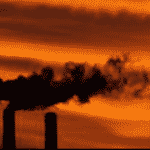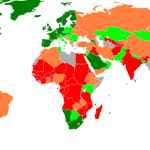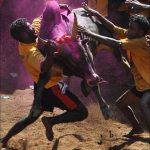MAJOR DOMAINS OF THE EARTH- Class 6- Geography Chapter 5
- The surface of the earth is a complex zone in which three main components of the environment meet, overlap and interact.
- The solid portion of the earth on which we live is called the Lithosphere.
- The gaseous layer that surrounds the earth is the Atmosphere.
- Water covers a very big area of the earth’s surface and this area is called the Hydrosphere. It comprises water in all its forms- ice, water and water vapour.
- The Biosphere is the narrow zone where we find land, water and air together, which contains all forms of life.
LITHOSPHERE
- The solid portion of the earth.
- It comprises the rocks of the earth’s crust and the thin layers of soil that contain nutrient elements which sustain organisms.
- Earth’s surface has two main divisions- continents (large landmasses) and ocean basins (huge water bodies).
- All the oceans of the world are connected to each other.
- The level of seawater remains the same everywhere. Elevation of land is measured from the level of the sea, which is taken as zero.
- The highest mountain peak Mt. Everest is 8,848 metres above the sea level.
Continents
- Seven major continents separated by large water bodies.
- Asia, Europe, Africa, North America, South America, Australia and Antarctica.
- A greater part of the landmass lies in the Northern Hemisphere.
- Asia –
- Largest continent.
- Lies in the Eastern Hemisphere.
- Tropic of Cancer passes through it.
- Separated from Europe by the Ural mountains on the west.
- Europe + Asia = Eurasia
2. Europe –
- The Arctic Circle passes through it.
- Bound by water bodies on three sides.
3. Africa –
- Second largest continent.
- The Equator or 0º latitude runs almost through the middle of the continent.
- A large part of it lies in the Northern Hemisphere.
- It is the only continent through which the Tropic of Cancer, the Equator and the Tropic of Capricorn pass.
- The Sahara Desert, the world’s largest hot desert, is located in Africa.
- It is bound on all sides by water bodies.
- The world’s longest river, the Nile, flows through Africa.
4. North America –
- Third largest continent.
- It is linked to South America by a very narrow strip of land called the Isthmus of Panama.
- An Isthmus is a narrow strip of land joining two landmasses.
- It lies completely in the Northern and Western Hemisphere.
- Three oceans, namely, the North Pacific Ocean, the North Atlantic Ocean and the Arctic Ocean surround it.
5. South America –
- It lies mostly in the Southern Hemisphere.
- The Andes, world’s longest mountain range, runs through its length from north to south.
- It has the world’s largest river, the Amazon.
6. Australia –
- Smallest continent.
- Lies completely in the Southern Hemisphere.
- It is an island continent.
7. Antarctica –
- It is a huge continent lying completely in the Southern Hemisphere.
- The South Pole lies almost at its centre.
- It is permanently covered with thick ice sheets.
- It has no permanent human settlements.
- Many countries have research stations in Antarctica including India.
- Research stations of India- Maitri and Dakshin Gangotri.
HYDROSPHERE
- Earth, also called the blue planet, is covered with – 71% water + 29% land.
- More than 97% of the Earth’s water is found in the oceans and is too salty for human use.
- A large portion of the rest is in the form of ice sheets and glaciers or under the ground.
- A very small percentage is available as fresh water for human use.
Oceans
- The ocean waters are always moving.
- The three chief movements of ocean waters are the waves, the tides and the ocean currents.
- The four major oceans are the Pacific Ocean, the Atlantic Ocean, the Indian Ocean and the Arctic Ocean.
- Pacific Ocean–
- Largest ocean.
- The greatest depth of 11,022 metres is recorded at Mariana Trench in the Pacific Ocean.
- It is almost circular in shape.
- Asia, Australia, North and South Americas surround it.
2. Atlantic Ocean–
- Second largest.
- S- shaped.
- It is surrounded by North and South Americas on the western side, and Europe and Africa on the eastern side.
- Its coastline is highly indented which provides ideal location for natural harbours and ports.
- From the point of view of commerce, it is the busiest ocean.
3. Indian Ocean–
- Almost triangular in shape.
- In the north, it is bound by Asia, in the west by Africa and in the east by Australia.
4. Arctic Ocean–
- It is located within the Arctic Circle and surrounds the North Pole.
- It is connected with the Pacific Ocean by a narrow stretch of shallow water known as Bering strait.
ATMOSPHERE
- It is the layer of gas surrounding the earth.
- It provides us with the air we breathe and protects us from the harmful effects of sun’s rays.
- It extends up to a height of about 1,600 km.
- It is divided into five layers based on composition, temperature and other properties.
- These layers starting from the earth’s surface are called the troposphere, the stratosphere, the mesosphere, the thermosphere and the exosphere.
- The atmosphere has- Nitrogen (78%), Oxygen (21%), and other gases like carbon dioxide, argon and others comprise 1% by volume.
- Oxygen- breath of life.
- Nitrogen- helps in the growth of living organisms.
- Carbon Dioxide- absorbs heat radiated by the earth, thereby keeping the planet warm. It is also essential for the growth of plants.
- An increase in the amount of carbon dioxide leads to increase in global temperatures. This is termed as global warming.
- The density of the atmosphere varies with height. It is maximum at the sea level and decreases rapidly as we go up. The climbers experience problems in breathing due to this decrease in the density of air. They have to carry oxygen cylinders for breathing at high altitudes.
- The temperature also decreases as we go upwards.
- The atmosphere exerts pressure on the earth which varies from place to place.
- Air moves from high pressure to low pressure. Moving air is known as wind.
BIOSPHERE
- It is the narrow zone of contact between the land, water and air.
- It is in this zone that life exists.
- All living organisms including humans are linked to each other and to the biosphere for survival.
- The organisms in the biosphere are broadly divided into the plant kingdom and the animal kingdom.
Miscellaneous
- Edmund Hillary (New Zealand) and Tenzing Norgay Sherpa (India) were the first men to climb the highest mountain peak Mt. Everest in the year 1953.
- Junko Tabei (Japan) was the first woman to reach the summit in the year 1975.
- Bachendri Pal was the first Indian woman to climb the highest peak in the year 1984.
- A strait is a narrow passage of water connecting two large water bodies.
- Palk Strait is the strait between India & Sri Lanka.
Read More: Class 6- Geography Chapter 3- Short Notes











